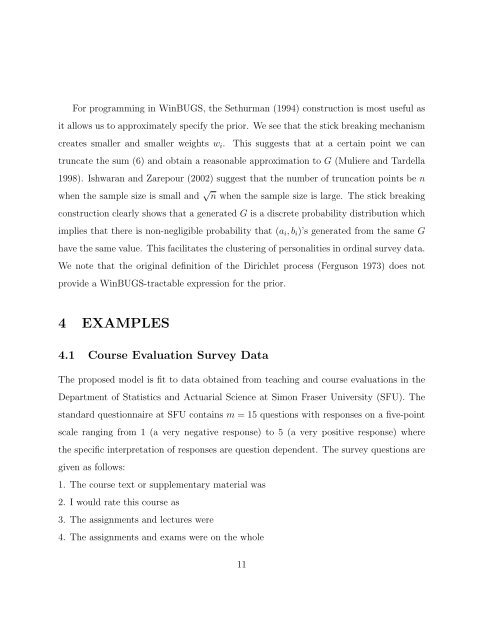Bayesian analysis of ordinal survey data using the Dirichlet process ...
Bayesian analysis of ordinal survey data using the Dirichlet process ...
Bayesian analysis of ordinal survey data using the Dirichlet process ...
You also want an ePaper? Increase the reach of your titles
YUMPU automatically turns print PDFs into web optimized ePapers that Google loves.
For programming in WinBUGS, <strong>the</strong> Sethurman (1994) construction is most useful asit allows us to approximately specify <strong>the</strong> prior. We see that <strong>the</strong> stick breaking mechanismcreates smaller and smaller weights w i . This suggests that at a certain point we cantruncate <strong>the</strong> sum (6) and obtain a reasonable approximation to G (Muliere and Tardella1998). Ishwaran and Zarepour (2002) suggest that <strong>the</strong> number <strong>of</strong> truncation points be nwhen <strong>the</strong> sample size is small and √ n when <strong>the</strong> sample size is large. The stick breakingconstruction clearly shows that a generated G is a discrete probability distribution whichimplies that <strong>the</strong>re is non-negligible probability that (a i , b i )’s generated from <strong>the</strong> same Ghave <strong>the</strong> same value. This facilitates <strong>the</strong> clustering <strong>of</strong> personalities in <strong>ordinal</strong> <strong>survey</strong> <strong>data</strong>.We note that <strong>the</strong> original definition <strong>of</strong> <strong>the</strong> <strong>Dirichlet</strong> <strong>process</strong> (Ferguson 1973) does notprovide a WinBUGS-tractable expression for <strong>the</strong> prior.4 EXAMPLES4.1 Course Evaluation Survey DataThe proposed model is fit to <strong>data</strong> obtained from teaching and course evaluations in <strong>the</strong>Department <strong>of</strong> Statistics and Actuarial Science at Simon Fraser University (SFU). Thestandard questionnaire at SFU contains m = 15 questions with responses on a five-pointscale ranging from 1 (a very negative response) to 5 (a very positive response) where<strong>the</strong> specific interpretation <strong>of</strong> responses are question dependent. The <strong>survey</strong> questions aregiven as follows:1. The course text or supplementary material was2. I would rate this course as3. The assignments and lectures were4. The assignments and exams were on <strong>the</strong> whole11
















